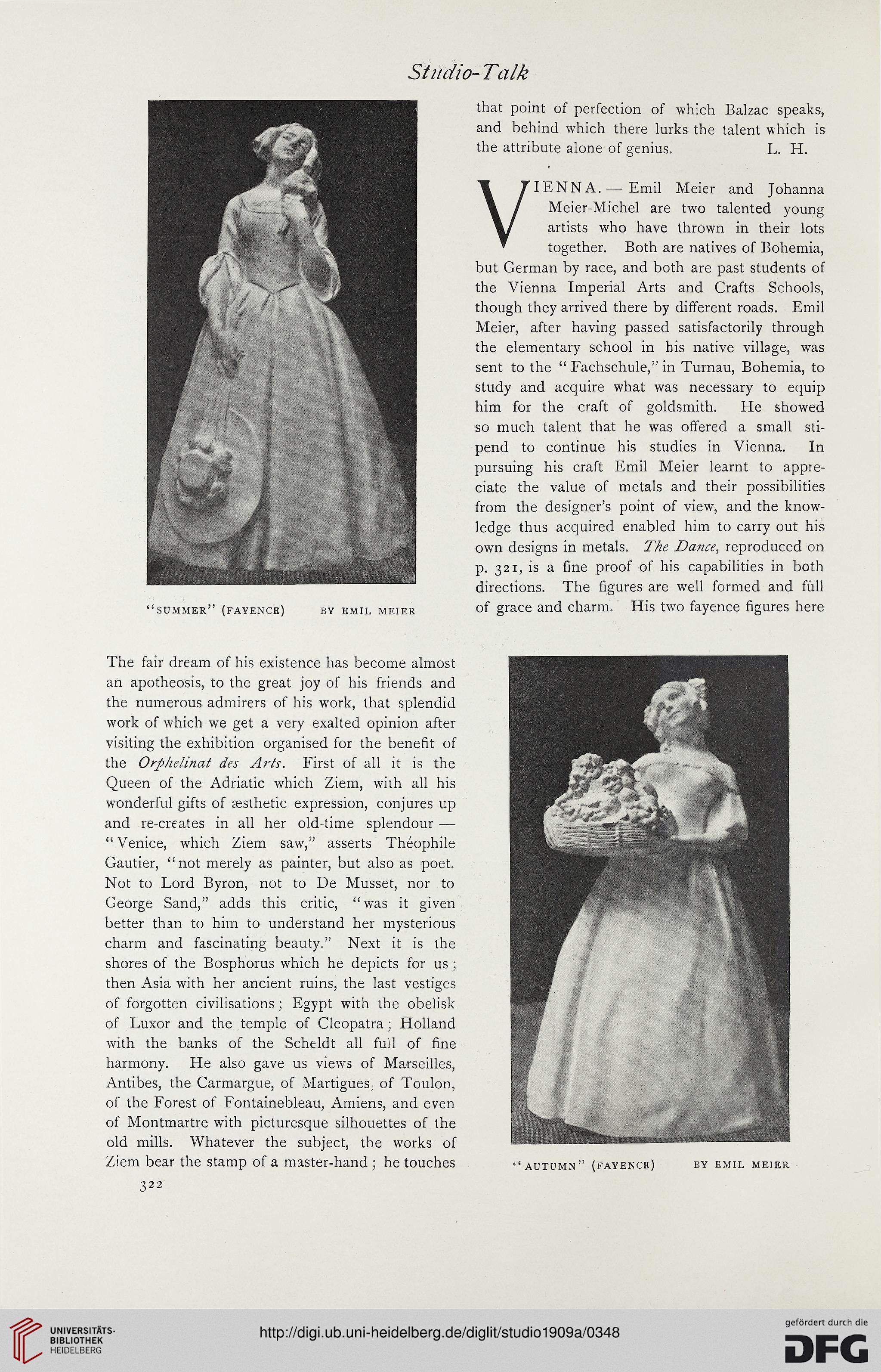Studio-Talk
“SUMMER” (FAYENCE) BY EMIL MEIER
The fair dream of his existence has become almost
an apotheosis, to the great joy of his friends and
the numerous admirers of his work, that splendid
work of which we get a very exalted opinion after
visiting the exhibition organised for the benefit of
the Orphelinat des Arts. First of all it is the
Queen of the Adriatic which Ziem, with all his
wonderful gifts of aesthetic expression, conjures up
and re-creates in all her old-time splendour —
“Venice, which Ziem saw,” asserts Theophile
Gautier, “not merely as painter, but also as poet.
Not to Lord Byron, not to De Musset, nor to
George Sand,” adds this critic, “was it given
better than to him to understand her mysterious
charm and fascinating beauty.” Next it is the
shores of the Bosphorus which he depicts for us;
then Asia with her ancient ruins, the last vestiges
of forgotten civilisations; Egypt with the obelisk
of Luxor and the temple of Cleopatra; Holland
with the banks of the Scheldt all full of fine
harmony. He also gave us views of Marseilles,
Antibes, the Carmargue, of Martigues; of Toulon,
of the Forest of Fontainebleau, Amiens, and even
of Montmartre with picturesque silhouettes of the
old mills. Whatever the subject, the works of
Ziem bear the stamp of a master-hand ; he touches
that point of perfection of which Balzac speaks,
and behind which there lurks the talent which is
the attribute alone of genius. L. H.
VIENNA.— Emil Meier and Johanna
Meier-Michel are two talented young
artists who have thrown in their lots
together. Both are natives of Bohemia,
but German by race, and both are past students of
the Vienna Imperial Arts and Crafts Schools,
though they arrived there by different roads. Emil
Meier, after having passed satisfactorily through
the elementary school in his native village, was
sent to the “ Fachschule,” in Turnau, Bohemia, to
study and acquire what was necessary to equip
him for the craft of goldsmith. He showed
so much talent that he was offered a small sti-
pend to continue his studies in Vienna. In
pursuing his craft Emil Meier learnt to appre-
ciate the value of metals and their possibilities
from the designer’s point of view, and the know-
ledge thus acquired enabled him to carry out his
own designs in metals. The Dance, reproduced on
p. 321, is a fine proof of his capabilities in both
directions. The figures are well formed and full
of grace and charm. His two fayence figures here
“autumn” (FAYENCE) BY EMIL MEIER
322
“SUMMER” (FAYENCE) BY EMIL MEIER
The fair dream of his existence has become almost
an apotheosis, to the great joy of his friends and
the numerous admirers of his work, that splendid
work of which we get a very exalted opinion after
visiting the exhibition organised for the benefit of
the Orphelinat des Arts. First of all it is the
Queen of the Adriatic which Ziem, with all his
wonderful gifts of aesthetic expression, conjures up
and re-creates in all her old-time splendour —
“Venice, which Ziem saw,” asserts Theophile
Gautier, “not merely as painter, but also as poet.
Not to Lord Byron, not to De Musset, nor to
George Sand,” adds this critic, “was it given
better than to him to understand her mysterious
charm and fascinating beauty.” Next it is the
shores of the Bosphorus which he depicts for us;
then Asia with her ancient ruins, the last vestiges
of forgotten civilisations; Egypt with the obelisk
of Luxor and the temple of Cleopatra; Holland
with the banks of the Scheldt all full of fine
harmony. He also gave us views of Marseilles,
Antibes, the Carmargue, of Martigues; of Toulon,
of the Forest of Fontainebleau, Amiens, and even
of Montmartre with picturesque silhouettes of the
old mills. Whatever the subject, the works of
Ziem bear the stamp of a master-hand ; he touches
that point of perfection of which Balzac speaks,
and behind which there lurks the talent which is
the attribute alone of genius. L. H.
VIENNA.— Emil Meier and Johanna
Meier-Michel are two talented young
artists who have thrown in their lots
together. Both are natives of Bohemia,
but German by race, and both are past students of
the Vienna Imperial Arts and Crafts Schools,
though they arrived there by different roads. Emil
Meier, after having passed satisfactorily through
the elementary school in his native village, was
sent to the “ Fachschule,” in Turnau, Bohemia, to
study and acquire what was necessary to equip
him for the craft of goldsmith. He showed
so much talent that he was offered a small sti-
pend to continue his studies in Vienna. In
pursuing his craft Emil Meier learnt to appre-
ciate the value of metals and their possibilities
from the designer’s point of view, and the know-
ledge thus acquired enabled him to carry out his
own designs in metals. The Dance, reproduced on
p. 321, is a fine proof of his capabilities in both
directions. The figures are well formed and full
of grace and charm. His two fayence figures here
“autumn” (FAYENCE) BY EMIL MEIER
322




